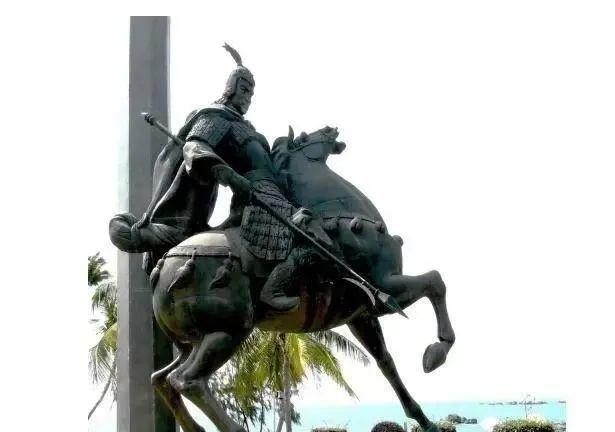Originally, Vietnam also belonged to China's territory, and it belonged to the South Vietnamese tribe together with Lingnan and Guangdong. However, due to the military decline of later dynasties, it was out of jurisdiction. The part of Vietnam that broke away must have a lot of opinions about the part of Lingnan, so it gave a derogatory term.
In 219 BC, the Qin army marched south to Baiyue, Jiaozhi County, Jiuzhen County, and Nichinan County.
During the Han Dynasty, during the Western Han Dynasty, the Fubo general Lu Bode during the Western Han Wu Emperor period, and the Fubo general Ma Yuan during the Eastern Han Guangwu Emperor period, repeatedly countered the rebellion in the South Vietnamese area. The Lingnan Fubo Ancestral Hall honors two Fubo generals from the Western Han Dynasty and The Eastern Han Dynasty's Xinshi Hou Mayuan, who made important contributions to the peace and stability of the Leiling and Lingnan and Guangdong regions, benefited the people, and were also praised by the rulers, and were many times enshrined by later emperors, making them "human gods" worshipped by the people. Emperor Huizong of Song made Lu Bode the King of Zhonglie, and in the second year of Xuanhe (1204), he made Ma Yuan the King of Zhongxianyoushun.

But in the Vietnamese part, it commemorates the Zheng sisters who were countered by Ma Yuan.
In May of the nineteenth year of Jianwu (43), Ma Yuan defeated Erzheng, who was defeated and died, and then destroyed the remnants of Erzheng in Jiuzhen. The Book of the Later Han Dynasty, Ma Yuanlie's Biography: "In the first month of next year, cut off the side of the conquest, march on the second, and pass on the first Luoyang." ”
But the Vietnamese "Complete History of The Great Yue History" committed suicide and died, and his subordinates committed suicide...
Cantonese-speaking Cantonese, like other Chinese immigrants speaking various dialects, are known in Vietnam as Tang Chinese, and they mainly settled in the South Vietnamese region, where they were identified as Ethnic Chinese (Han Chinese) after the founding of the People's Republic of Vietnam, including Hakka who migrated to Vietnam after 1840. Vietnam referred to the Hakka dialect (a Hakka dialect with the bottom layer of the She language) who moved into northern Vietnam before 1840, and the villagers and Lê people, collectively known as the Ai ethnic group, settled mainly in the areas of North Vietnam near China, and their main component was a Hakka-speaking group, identifying with the ancestral origin in the Fang Cheng Gang Wu Dong area. After the outbreak of Chinese exclusion, a large number of people moved to South Vietnam, most of them were registered as Hua, Shanyou, Dai, etc., and only more than 1,600 people were currently registered as Ai, and they are integrating into other ethnic groups.
The migration of ethnic groups in southern China to Southeast Asia is mainly due to the following reasons:
First, the turmoil of the war to change the dynasty triggered the avoidance of chaos and migration.
Second, the implementation of the government's policy of changing land and returning to the country triggered the Tusi rebellion and fled after being defeated.
Third, the Turks' great weapon fight triggered the Taiping Heavenly Kingdom Movement, which led to the migration of a large number of southern people. Cantonese-speaking ethnic groups originally had little motivation to migrate, because in addition to the Zhuang Dong ethnic group in Lingnan, the Cantonese Cantonese Cantonese people were the earliest Han ethnic groups formed in Lingnan, and they occupied the best land and had no internal cause for outward migration. Until the outbreak of the Taiping Heavenly Kingdom Movement, the Cantonese people moved overseas under the strong influence of external forces.
It turns out that many of the previous claims that the Shanyu ethnic group common Cantonese dialect were caused by false rumors without field investigation. Strictly speaking, the Shanyu people use the Sheyao dialect, which is deeply influenced by Hakka and Cantonese. Self-proclaimed Shanyao, it is mainly distributed in the semi-mountainous areas of Taiyuan, Vinh Phuc, Bac Giang, Quang Ninh, Xuan Quang and other provinces in northern Vietnam, with a population of more than 100,000. Where did this nation come from? They mainly identify with the late Ming and early Qing dynasties, that is, in the early 17th century, from Boluo County and Guishan County in China to the semi-mountainous areas of northern Vietnam.
The Shanyu ethnic group is both a mountain ethnic group and a Cantonese speaker, which is a very rare case.
Generally, the immigrants in the mountainous areas of southern China are Miao-Yao ethnic groups and Han Hakkas, and the existing Yao areas in Guangdong are surrounded by Hakka. The Yao people in Guangxi are the richest in China in terms of numbers and branches, and there are many Yao areas next to both Hakka and Cantonese areas, which provides the possibility of Cantonese objectification of some Yao ethnic groups.
In the Boluo area of Guangdong Province, there are still thousands of Shes living groups, they speak a Miao-Yao language, and there are both Cantonese and Hakka people around them. I speculate that a certain ethnic group living in the Boluo Mountains migrated westward because of the outside world, forming a mixed language of Hakka and Cantonese in Guangxi, which was passed through the ethnic group before entering Vietnam. To sum up, it is not in line with the facts to say that the Cantonese language is common to the Shanyu ethnic group, nor can it simply correspond directly to which ethnic group identified by China, and Vietnam has not classified the Cantonese as the Shanyu ethnic group. It can only be said that it is a nationality delineated by Vietnam according to the actual situation.